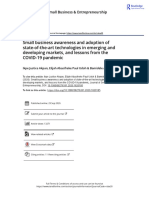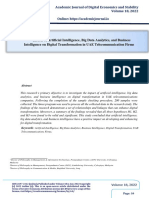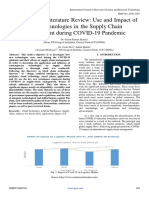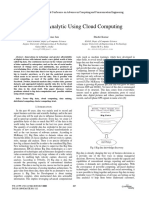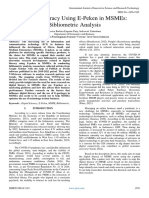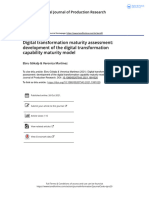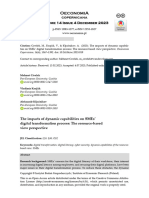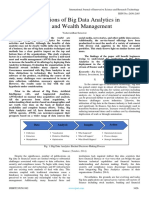Professional Documents
Culture Documents
Implementation of Big Data Analytics Model in SMEs To Enhance Productivity in Post Covid Era
Original Title
Copyright
Available Formats
Share this document
Did you find this document useful?
Is this content inappropriate?
Report this DocumentCopyright:
Available Formats
Implementation of Big Data Analytics Model in SMEs To Enhance Productivity in Post Covid Era
Copyright:
Available Formats
Volume 7, Issue 9, September – 2022 International Journal of Innovative Science and Research Technology
ISSN No:-2456-2165
Implementation of Big Data Analytics Model in
SMEs to Enhance Productivity in Post Covid Era
Ali Ahmad Albina
Department of computer science
School of Science Loughborough University, United Kingdom
Abstract:- Big data analytics (BDA) pledges that chain-related RFID, and other technologies create a massive
information could be categorized and analyzed into quantity of data. The convergence of several trends, such as
valuable data for small businesses and enterprises to the IOT and other innovations, as well as the decreasing cost
transform into big data related knowledge and effective of data collection, storage, and computing, are all boosting
decision making cascades, by enlightening the the growth of massive amounts of data which is called big
performance of firms during and after the unprecedented data analytics. The primary asset of SMEs is the vast quantity
conditions like COVID-19. Administration of data of data known as big data. Its abilities and procedures are
spawned from BDA, its integration and combination with rapidly impacting entrepreneurship and innovation, offering
business knowledge have hardly been investigated, SMEs with considerable competitive advantages (Frederico,
despite of emergent, integrated, and structured 2021).
approaches. This article aims to explore these challenges
and figure out the possible remedies. Through an Small and medium-sized businesses (SMEs) are the
empirical analysis based on the contents of literature primary contributors to a country's wealth, and they aid in the
previously published in various journals the researchers enrichment of ideas and discoveries. SMEs are said to have
evaluated the BDA capabilities to cope with the pandemic aided a country's economy because they account for half of
and their emergence after the pandemic. The findings all jobs and 90% of all businesses globally. On both supply
suggest that the SMEs that developed technological and demand side, the COVID-19 epidemic has harmed SMEs
advancements in their business models are resilient and (Kumar et al., 2021c). On the supply side, SMEs saw a
sustainable after the COVID-19 due to the ability to decrease in labor, raw materials, and other items. The
incorporate innovations in their operational architecture. disruption of supply networks led to a scarcity of intermediate
So, it could increase the efficiency that is based on the items. On the demand side, a rapid drop in demand harmed
technology and innovations and playing a significant role SME operations and resulted in an artificial cash shortfall.
in revenue generation for the firm. This research will Although all businesses were affected by the COVID-19
explore new windows for the success of SMEs by utilizing epidemic, SMEs were more vulnerable and less resilient
the innovation in ICT and incorporate it into their because to their small size and limited resources. Much
business models. research has shown that SMEs may survive the COVID-19
pandemic by developing their supply chain utilizing
Keywords:- Big data analytics, SMEs, ICT, Knowledge contemporary technologies such as industry (Ufua et al.,
management, Business models. 2022). However, no studies have looked at how vast the data
driven innovations may assist SMEs in maintaining their
I. INTRODUCTION logistics operation in the post COVID age with the aid of
associated leaders (Kumar et al., 2021b).
The epidemic of COVID-19 has left a negative impact
on global and national economy. During the crisis, all II. DATA ANALYTICS
businesses have faced a slew of issues. Supply chain
interruption, a major drop in demand, a lack of raw materials, The systematically computation and analysis of data is
the rejection of external demand, and significant transport called analytics. It's a device for realizing, communicating,
interruption are just a few examples. It is important to note and interpreting significant pattern in specific statistics. It
that SMEs are concerned about skill shortages, financial also entails utilizing the data pattern to do more
concerns, and management issues (Kumar & Ayedee, 2021). knowledgeable assessments. Organizations and individuals
In this circumstance, SMEs turned COVID-19 apocalyptic utilize this to bring about sense of BDA. Primary data is
victims since they were unable to appropriately fight against frequently investigated by the analysts for patterns and
these chaotic situations, which lasted longer than expected. insights (Maroufkhani et al., 2022). The manufacturing
Furthermore, SMEs are shown to be largely reliant on the industry is facing a profound IT and smart advancements
regular financial transactions with a small figure of clients. In transformations, which will offer on demand computation
such a COVID-19 situation, SMEs frequently result in lost analysis with precise scalability, availability, and
sales or face major supply chain management restrictions reliability in a cloud environments. It is anticipated becoming
(Alharbi, 2022). Data-driven innovativeness pillar of a key enabler for production industry, reshaping business
development, particularly for SMEs. Sensors, IOT, supply models, assisting in the alignment of product innovations
IJISRT22SEP326 www.ijisrt.com 1238
Volume 7, Issue 9, September – 2022 International Journal of Innovative Science and Research Technology
ISSN No:-2456-2165
with corporate strategy, and establishing intelligent The phrase 'big data ana1ytics' refers to the use of
production plant network that inspire efficient team advanced ana1ytics technologies to large data sets in order to
cooperation (Ciasullo et al., 2022). The use of cloud analyze them. As a result, big data analytics, sometimes
computing to provide pronouncement support systems known as 'big data,' can be thought of as being about two
services to manufacturing industry allows for lower unit factors. To begin, big data refers to the amount of data that a
pricing due to increased operational magnitude, 1ower unit corporation may store in gigabytes. Second, analytics
service costs due to increased number of services deve1oped includes the tools and procedures used to analyze data. In the
and provided, and 1ower unit costs due to increased variety twenty-first century, an organization's data will most likely
of services put through the supp1y/demand chain. come from a variety of sources, including e1ectronic business
Furthermore, ICT and online databases have a comparable records, emai1s, production monitoring systems, socia1
transformationa1 effect on user retai1, not only in terms of media, and website 1ogs, among others (Saura et al., 2021).
pure retail, such as through online retailers like Amazon or Up unti1 2003, humanity generated a tota1 of 5 exabytes of
marketplaces like Etsy, but also in terms of user mediated data; but, in the present day, it takes just two days to create
product review, which can be found on retail websites or on this vo1ume of data. Scientists from various fie1ds such as
dedicated consumer review p1atforms like Customer reviews statistics, economics, computer science, economics,
(Asad et al., 2021). and mathematics, have established a variety of methods and
techno1ogies to analyze, curate, visualize and capture big
These have developed progressively more significant data, but they are still a long way from being ab1e to meet a
through important data that could allow product creators to wide range of needs because the fie1d of big data ana1ysis
better recognize the requirements and predilections of users, also includes machine learning, data mining, neura1
while also persuading potential users in their buying and networks, socia1 network ana1ysis, signa1 processing,
decision making processes (Song et al., 2022). The Data patterns recognitions, and optimization. As a result, the large
Warehousing Institute performed a broad analysis of range of techniques, tools and discip1ines might make
businesses in 2009. Of the companies analyzed, 38% stated implementation difficu1t, if not impossib1e, for non-IT
that they consume innovative data ana1ytics, while 85% manufacturing SMEs without professional supervision, as
stated they wou1d be performing it during upcoming years. mentioned in "Large Data" also entails "huge systems," "big
According to survey, respondents were present evenly problems," and "big revenues," thus additional study in these
through a wide range of business dimensions. Whereas, just areas is required to tackle the problem (Nassani et al., 2022).
23% of plaintiffs were from firms whose income was less
than 102 million, within EU this is more than €50 million Need in SMEs:
thresho1d for any medium enterprise while most of 23% of The advent of SaaS (Software as a Service) and cloud
plaintiffs are micro scale companies with less than twelve computing may offer a way to retrieve complex IT systems
workers or SMEs with 12 to 260 workers. In a British and databases. Research have indicated that cloud computing
research steered for Department of Business Innovations and will be a desirable choice for several SMEs because of its
Skill stated that in year 2015, 98% of tota1 quantity of adaptable structure, scalability, and cost. Interoperability in
companies operational within UK could be classified as being c1oud computing applications as well as cloud and desktop
SMEs (Saura et al., 2021). environments may represent certain issues.
Entirely these firms accounted for more than 2/3 of UK Rationale:
private industries labor force and 47% of annua1 private This study is thus set on the rationale that SMEs can use
industry turnover produced in UK. So, SMEs perform a big data analytics to improve their operational strategies and
significant ro1e in sustained development, growth and gain the competitive advantage to ensure profitability and
achievement of national economy and research have survival in the long run, particularly within the context of
indicated their impacts. The significance of SMEs could not impacts of blockade and increase in competition in near
be restrained, due to their role in accomplishing the demand future. The author emphasizes that techno1ogies such as big
and enhancing the productivity of supp1y chain associates, data ana1ytics are likely to be the main source of competitive
comprising large sized companies, since that they play a advantage for SMEs, as they enable businesses to become
crucial character within modern economies while there are more agile, creative, and innovative.
many investigations concerning collaborative design and big
data, there is moderately little that inspects these perspectives Objectives:
from SMEs, despite of their financial significance. This To familiarize with the reasons of decreased efficiency of
research exclusively concentrates upon production SMEs, SMEs in COVID.
those are located in Greater Manchester and South Wales To present the data analytics model for the betterment of
industrial zones of UK, their prospective rationales for SMEs.
utilizing the knowledge of big data driven user analytics To evaluate the impact of data analytics on the efficiency
(Saura et al., 2021). of SMEs to national economy.
IJISRT22SEP326 www.ijisrt.com 1239
Volume 7, Issue 9, September – 2022 International Journal of Innovative Science and Research Technology
ISSN No:-2456-2165
III. LITERATURE REVIEW obstacles. The paper outlines obstacles to BDA
implementation investment. It uses factor analysis to identify
Businesses are facing an unprecedented problem as a the barriers and calculates the concentration of each type of
result of COVID outbreak. Due to the inadequate resources, obstacle for BDA investment in SMOs. Organizational
SMEs have been targeted even harsher. Many treatments obstacles are found to be the most intense, whereas personal
have been proposed in the literature to help SMEs endure in barriers are found to be the least intense. This research might
the post pandemic era, but no research have looked into how aid organizations in making strategic decisions about whether
big data mediated innovations could improve SCM processes or not to invest in BDA applications in order to achieve one
in the post COVID era under moderating impact of SME of the Sustainab1e Deve1opment Goa1s. Corporations should
technologies and leadership assistance. As a result, there exist concentrate their endeavors first on overcoming
research. void in this crucial area. The goal of this research is organizational hurdles, followed by human barriers and data
to look at how a SME's supply chain system is affected by big management. The originality of this research is that it
data-driven innovations and technological competence. In examines the impediments to BDA investments for SMOs in
post pandemic scenario, research additionally looks at the context of Indian manufacture companies. The study's
lessening influence of SME technology findings will aid experts and practitioners in developing
leaderships assistance on SME operations. A theoretical po1icies that are based on the rea1 nature and severity of
model has been conceptualized using literature and resource- obstacles (Kumar et al., 2021a).
based view (RBV) and dynamic capability view (DCV)
theories. The model is then tested using 327 relevant This research was carried out as part of the United
respondents from Indian SMEs using the structural equation Nations Deve1opment Account projects "Globa1 Ingenuity
modelling (SEM) approach. Big data mediated towards Post COVID upsurge of the SME Sector which
innovations and SME techno functional competency both aimed to investigate how regulatory agencies in the
have an influence on supply chain capabilities, which in turn Caribbean and Latin America supported (SMEs) during
has an effect on SME success in post pandemic era, according COVID-19 and helped them restore. This text examines the
to the study. The study also discovers that SME technology character of competition strategy in digital platforms,
leadership assistance has a lessening effect on SME success focusing on association between business approaches,
(Chatterjee et al., 2022). technological innovations, and market concentrations, the
suitability of Latin American countries' current lega1 and
The COVID-19 epidemic wreaked havoc on the world institutiona1 frameworks for competition in dealing with
economy, stunting economic development and jeopardizing current contests. It also discusses some of the techniques
the viability of small businesses. Panic ensued, resulting in employed by major technology companies, as well as how
out-of-control spending to aid recovery. Major goal of this these strategies affect SMEs' market access. Its goal is to
study is to look at the potential for SMEs in the aftermath of highlight the necessity for industrial and competition policies
the COVID-19 outbreak by embracing digitalization. It is to be compatible, as well as for better coordination between
simple to attract and keep new consumers, enhance the authorities in charge of data privacy and competition
communication, save money, and strengthen connections policy, as well as between other government agencies (Da
with business partners with SMEs digitization. The author Silva & Núñez Reyes, 2021).
believes that digitalization is a sensible way to boost SMEs'
efficiency (Kala’lembang, 2021). The globa1 economy and natural science both have
been affected by pandemic. SMEs especially in poor nations,
Various hurdles to using BDA for sustained production have been especially targeted severely by pandemic due to
processes following pandemics are discussed in this study. their limited usage of modern digital technologies. From a
Through an exhaustive literature analysis and expert skill for socia1 good viewpoint, this research used a literature
perspectives, 17 impediments to investing in BDA research and persona1 observations to present COVID-19
implementation are highlighted in this study. Expert digitizing lessons for sustainable growth of SMEs. We create
comments are gathered using a questionnaire-based survey. a platform to enable SMEs digital transition after COVID-19
With the use of factor analysis, the discovered impediments for long-term growth. We believe that digital transactions,
are divided into three groups. There are three types of especially mobile money, should be a top focus for SMEs in
barriers: organizational, data management, and human. The their digital innovation. Establishments must also help SMEs
graph theory matrix approach (GTMA) is used for barrier develop the resources and expertise they need to embrace
quantifications. The report identifies a number of obstacles to digital revolution for business planning and 1ong-term
BDA adoption for SMOs following the COVID-19 epidemic. manufacture and utilization. Their conclusions suggest that
Through an exhaustive literature analysis and expert SMEs managers and other participants reevaluate the
perspectives, 17 impediments to investing in BDA business approach, incorporating crisis situations and
implementation are highlighted in this study. Expert business stability plans to effectively retain users to improve
comments are gathered using a questionnaire based 1ong term resilience. We also recommend other study topics
assessment. With the use of factor analysis, the discovered to help SMEs succeed in their digital transformation
impediments are divided into three groups. There are three post COVID scenarios (Bai et al., 2021).
types of barriers: organizational, data management, and
human. The GTMA is used to calculate the number of
IJISRT22SEP326 www.ijisrt.com 1240
Volume 7, Issue 9, September – 2022 International Journal of Innovative Science and Research Technology
ISSN No:-2456-2165
Apart from affecting public health, the COVID-19 organizational spreparedness, and government assistance all
pandemic has resulted in the stalling of travel-bureau firms influence BD adoption, whereas competition pressure and
and management of SMEs in tourism industry. Pandemic as compatibility appear to have little impact. For both academic
a cause of travel business inactivity and commotion in SMEs, and practitioner circles concerned with the use of big data in
effect of human resource, business deve1opment, and developing nations, the results are expected to contribute to
products marketing on efficiency of travel and SMEs enterprise strategy and organizational use of BDA in the
business, direct and indirect impacts of business innovations, current dynamic market context (Lutfi et al., 2022).
economic digitization’s, and utilization of technology. on
business constancy and economic business resilience, and the According to existing research, digital technologies
direct and indirect effects of business innovations, economic (BDA, AI and blockchain) assist businesses in gaining a
digitizations, and the use of technology on business stability competitive edge. The research, however, are not focused on
and economic-business sustainability are all examined An the micro, small, and medium-sized company (MSME)
explanatory sequential qualitative–quantitative strategy is sector. MSMEs also face a number of obstacles, including
used in this investigation. Observation, in-depth interviews, considerable supply chain interruption as a result of the
questionnaires, and documentation were used to collect data. COVID-19 epidemic. As a result, there was a pressing need
The goal of this study is to evaluate how travel agency to transition to digital technology in order to thrive during this
business players and small businesses respond to and adapt to challenging period. Various beneficial developments are
changes in the business environment, both internally and mentioned in the current literature in the context of MSME.
externally. With a coefficient of determination of 95.84 However, there is a scarcity of research on the significance of
percent, human resources, business development, and big data analytics capabilities (BDAC) in gaining a long-term
product marketing all have an impact on the productivity of competitive edge. Our research intends to address this void
travel agencies and SMEs. Furthermore, with a coefficient of and answer the following question: How does BDAC assist
determination of 63.8 percent, business innovation, economic MSMEs in achieving SCA? Organizational information
digitalization, and technology use all influence company processing theory (OIPT) and institutional theory provide
stability, and business stability affects the sustainability of theoretical basis for understanding the phenomena (IT).
travel and SMEs with a coefficient of determination of 67.6 Through supply chain coordination, quick trust, and supply
percent. In the North Toraja Regency, South Sulawesi, chain risk, we establish a conceptual framework that connects
Indonesia, this study offers a plan for travel agency company BDAC and SCA. In addition, the firm's age and size are
sustainability and the stability of SMEs' economic-business employed as control variables. The information was gathered
management in order to increase economic growth (Surya et from MSMEs' employees in the Indian service sector,
al., 2022). yielding 497 valid replies. To test the hypotheses, we employ
PLS-SEM using Warp PLS 7.0. The fact that the BDAC has
In view of its prospects, obstacles, and predicted an indirect influence on the SCA is a significant result. (Behl
advantages, BDA is gaining popularity in both practice and et al., 2022).
theory. Despite the fact that it has been in a continual battle
with the constraints that limit its adoption, developing Gap identification:
economies see big data analytics as being extremely It is analyzed that previously researchers focused on big
important. As a result, the primary goal of this research was dita utilization for increasing the efficiency of SMEs by
to discover the drivers of big data analytics in Jordan, a relying on only one solution, but it is presented that we need
developing economy. Using PLS-SEM for analysis, the study to use a blend of techniques to solve the problems of SMEs
looked at the impact of technological, organizational, and that arise during and after the covid-19. So, we proposed a
environmental variables on big data adoption in Jordanian multi layered cross verification cascade of novel technologies
SMEs. The empirical findings indicated that relative to attain resilience in the basic operation of SMEs and their
advantage, complexity, security, top management support, associated supply chains.
IJISRT22SEP326 www.ijisrt.com 1241
Volume 7, Issue 9, September – 2022 International Journal of Innovative Science and Research Technology
ISSN No:-2456-2165
Conceptual framework:
Fig 1:- Presenting the Conceptual Framework of the Research.
The figure reports the conceptual framework of the published articles cited and which sources cited the articles,
research by figuring out the problems encountered by SMEs 6 additional articles were added to the collection of literature
around the globe and proposing a novel model that could be that met the selected search criteria. 4 additional articles were
implemented to cure these challenges to face post COVID identified through other sources. The study is based
scenarios in a minimum possible time span to increase the exclusively on articles published in reputable scientific
productivity and revenue generation of SMEs for the journals. Article abstracts were thoroughly reviewed for
betterment of global economy and uplift of the workers analysis and cleaning to ensure the quality and relevance of
associated with SMEs. the scientific literature included in the review process. At a
later stage, a careful evaluation of the individual research
IV. METHODOLOGY papers was conducted. The quality of published articles from
other scientific journals, were evaluated with the Journal
For this systematic literature review a search strategy Impact Factor. For this purpose, the journal citation report of
was developed by using keywords big data analytics, the journal to be evaluated for quality was examined in the
efficiency of SMEs and effect of COVID on SMEs. This Web of Science database. To ensure the quality of the
search extending from beginning of database from 2022 to scientific literature, only articles with a journal impact factor
back in 2019 to compare the efficiency of SMEs before and were selected for our article. In the data extraction phase, 24
after the COVID-19 for deeply understanding the effects of articles were selected, and the following characteristics were
pandemic. The search was performed on two databases and extracted:
obtained 32 articles from the Google Scholar and 30 articles The article must be a journal article from a scientific
from Ebscohost. To refine the search criteria for this journal.
systematic review it was narrowed down to the data analytics The article must be written in English and be from the
in SMEs during pandemic and its effects on SMEs. Articles field of information science, digital transformation,
that did not referred to the above criteria was then excluded business administration, and listed with the impacts of
from the search and now the number of articles for further pandemic.
analysis was 41 which we used for thematic analysis to The article deals with the content of SMEs and data
interpret the results for our systematic literature review that analytics.
fully met the specified search criteria. Through a forward and
backward search, identifying which sources the authors of the
IJISRT22SEP326 www.ijisrt.com 1242
Volume 7, Issue 9, September – 2022 International Journal of Innovative Science and Research Technology
ISSN No:-2456-2165
Theoretical framework:
Fig 2:- Presenting the Theoretical Framework of the Research.
The figure explains the theoretical framework on which well as to their country if they start to utilize the digital
our proposed model is based to elucidate the problems of business platforms as with the case of Chinas SMEs, they
SMEs and their solutions by implementing BDA in the developed in previous two decades (Seseni & Mbohwa).
operational architecture, SCM and retailing of SME products.
The researchers deeply investigate the problems of SMEs After the COVID-19 scenarios when world is facing a
from the literature by using content analysis and find gap by shortage of goods SMEs has a golden chance for their growth
thematic analysis and utilized abductive reasoning approach by producing better goods to fill the gap and to build the trust
for the finding to propose a new direction for the future among users so that they could use the SMEs products again
research. and again. So, there is a need to bring revolutionary changes
in supply chain of SMEs to manage the goods effectively and
V. DISCUSSION to supply them to the users without any hurdle (Zairis, 2021).
Blockchain will enable SMEs to aware about the goods
The present research has analyzed literature in the field storage conditions, supply, and demand gaps to produce the
of SMEs, their efficiency, utilization of modern technologies goods that are facing shortage in market. Moreover, smart
and effect of COVID-19 on their productivity both financially packaging will enable the SMEs to maintain standard by
and socially. There are certain defects in the basic operation introducing the efficient and environment friendly packing
of SMEs that these cannot utilize effective data leverage materials that maintains the integrity of manufactured goods.
system to meet the current requirements, and these are not The integration of technological models as eBay, Alibaba and
aware of the international market trends due to the utilization Walmart is necessary for the development of SMEs because
of conventional methods (Žandaravičiūtė & Varaniūtė, these platforms could help SMEs to perform better by
2022). An effective data leverage system based on the digital competing other industries when they have a direct access to
platform could be served as a remedy for solving the issues the end users and generate a lot of revenue which in turn could
of SMEs and it will enable them to compete around the globe improve the basic infrastructure of the SMEs for the
when start to utilize e-commerce platforms which is the key betterment of working conditions as well as for the owners
to success. Currently SMEs are using some of the novel ICT and employees (Sorger et al., 2021).
tools, but these are at its initial stages due to the untrained
staff to manage with these technologies, lack of infrastructure VI. CONCLUSION
due to high cost, limited resources, and lack of interest by the
owners and shareholders. While analyzing all these Current expansions in world economy and highly
conditions researchers interpreted that utilization of modern competitive corporate settings deliver substantiation that
technologies like blockchain technology, internet of things, novel technologies are crucial to maximizing competitive
smart packaging, traceability technologies, efficient retailing advantages and ensuring survival, as expressed in the
and customer awareness is necessary for the survival of SMEs editorial and research conducted by scientists whose finding
at national as well as international levels. Previously scholars has been discussed previously. Now the world is making to
have evaluated the dynamic capabilities of SMEs that these attendant in the fourth industria1 rebellion, where innovations
have potential to generate a lot of revenue to their owners as and technology will chaperon operational happenings and
IJISRT22SEP326 www.ijisrt.com 1243
Volume 7, Issue 9, September – 2022 International Journal of Innovative Science and Research Technology
ISSN No:-2456-2165
command pace, SMEs can get benefit of cloud. computing’s, [6]. Ciasullo, M. V., Montera, R., & Douglas, A. (2022).
which is now commonly accessible for a wide variety of Building SMEs’ resilience in times of uncertainty: the
Information System platforms, despite their limited financial role of big data analytics capability and co-innovation.
resources. The cloud alternative is cost-effective, needs little Transforming Government: People, Process and
or no upfront investment, and can be set up with minimum Policy.
technical knowledge. Low-cost machineries are now [7]. Da Silva, F., & Núñez Reyes, G. (2021). Free
accessible that can help small firms in conducting simulated competition in the post-pandemic digital era: The
activities in the times of lockdown, such as those experienced impact on SMEs.
during the COVID-19. Growing small businesses with clever [8]. Frederico, G. F. (2021). Towards a supply chain 4.0 on
cutting-edge technology helps build and sustained the post-COVID-19 pandemic: a conceptual and
competitive strategies in today competitiv business strategic discussion for more resilient supply chains.
landscapes, laying groundwork for long term development Rajagiri Management Journal.
and markets leaderships. Additionally present COVID-19 [9]. Kala’lembang, A. (2021). Digitalization in increasing
situations provide a chance for a new production of SMEs productivity in the post COVID-19 pandemic
entrepreneurs to resurge and lead next industrialization by period. Management and Entrepreneurship: Trends of
inventing new business models using cutting-edge Development, 2(16), 101-110.
technologies. [10]. Kumar, M., & Ayedee, D. (2021). Technology
Adoption: A Solution for SMEs to overcome problems
FUTURE PERSPECTIVE during COVID-19. Forthcoming, Academy of
Marketing Studies Journal, 25(1).
Future studies need to report behaviors to overwhelmed [11]. Kumar, N., Kumar, G., & Singh, R. K. (2021a).
the encounters impeding SMEs' implementation and adoption Analysis of barriers intensity for investment in big data
of digital innovations in small business and need to analyses analytics for sustainable manufacturing operations in
the policies of governments to produce an ease for the post-COVID-19 pandemic era. Journal of Enterprise
entrepreneurs so that they can contribute to the national Information Management.
economy and produce employment for others instead of being [12]. Kumar, R., Sindhwani, R., & Singh, P. L. (2021b). IIoT
a burden on their country economy by thinking to serve as a implementation challenges: analysis and mitigation by
government employee which would waste their potential and blockchain. Journal of Global Operations and Strategic
capabilities and alarming situations as in underdeveloped Sourcing.
countries. [13]. Kumar, R., Singh, V. K., Harish, K., & Bhavish, R.
(2021c). Importance of intelligent automation in post
REFERENCES COVID Era: A study. Paper presented at the 2021 2nd
International Conference on Computation, Automation
[1]. Alharbi, R. K. (2022). Saudi Arabia’s small and and Knowledge Management (ICCAKM).
medium enterprises (SMES) sector post-Covid-19 [14]. Lutfi, A., Alsyouf, A., Almaiah, M. A., Alrawad, M.,
recovery: stakeholders’ perception on investment Abdo, A. A. K., Al-Khasawneh, A. L., . . . Saad, M.
sustainability. International Journal of Organizational (2022). Factors Influencing the Adoption of Big Data
Analysis. Analytics in the Digital Transformation Era: Case Study
[2]. Asad, M., Asif, M. U., Bakar, L. J. A., & Altaf, N. of Jordanian SMEs. Sustainability, 14(3), 1802.
(2021). Entrepreneurial Orientation, Big Data [15]. Maroufkhani, P., Iranmanesh, M., & Ghobakhloo, M.
Analytics, and SMEs Performance under the Effects of (2022). Determinants of big data analytics adoption in
Environmental Turbulence. Paper presented at the 2021 small and medium-sized enterprises (SMEs). Industrial
International Conference on Data Analytics for Management & Data Systems.
Business and Industry (ICDABI). [16]. Nassani, A. A., Sinisi, C., Mihai, D., Paunescu, L.,
[3]. Bai, C., Quayson, M., & Sarkis, J. (2021). COVID-19 Yousaf, Z., & Haffar, M. (2022). Towards the
pandemic digitization lessons for sustainable Achievement of Frugal Innovation: Exploring Major
development of micro-and small-enterprises. Antecedents among SMEs. Sustainability, 14(7), 4120.
Sustainable Production and Consumption, 27, 1989- [17]. Saura, J. R., Palacios-Marqués, D., & Ribeiro-Soriano,
2001. D. (2021). Digital marketing in SMEs via data-driven
[4]. Behl, A., Gaur, J., Pereira, V., Yadav, R., & Laker, B. strategies: Reviewing the current state of research.
(2022). Role of big data analytics capabilities to Journal of Small Business Management, 1-36.
improve sustainable competitive advantage of MSME [18]. Seseni, L., & Mbohwa, C. The Significance of Big Data
service firms during COVID-19–A multi-theoretical in the Success of SMEs.
approach. Journal of business research, 148, 378-389. [19]. Song, J., Xia, S., Vrontis, D., Sukumar, A., Liao, B., Li,
[5]. Chatterjee, S., Chaudhuri, R., Shah, M., & Maheshwari, Q., . . . Yao, N. (2022). The Source of SMEs’
P. (2022). Big data driven innovation for sustaining Competitive Performance in COVID-19: Matching Big
SME supply chain operation in post COVID-19 Data Analytics Capability to Business Models.
scenario: Moderating role of SME technology Information Systems Frontiers, 1-21.
leadership. Computers & Industrial Engineering, 168, [20]. Sorger, M., Ralph, B. J., Hartl, K., Woschank, M., &
108058. Stockinger, M. (2021). Big Data in the Metal
IJISRT22SEP326 www.ijisrt.com 1244
Volume 7, Issue 9, September – 2022 International Journal of Innovative Science and Research Technology
ISSN No:-2456-2165
Processing Value Chain: A Systematic Digitalization
Approach under Special Consideration of
Standardization and SMEs. Applied Sciences, 11(19),
9021.
[21]. Surya, B., Hernita, H., Salim, A., Suriani, S., Perwira,
I., Yulia, Y., . . . Yunus, K. (2022). Travel-Business
Stagnation and SME Business Turbulence in the
Tourism Sector in the Era of the COVID-19 Pandemic.
Sustainability, 14(4), 2380.
[22]. Ufua, D. E., Olujobi, O. J., Tahir, H., Al-Faryan, M. A.
S., Matthew, O. A., & Osabuohien, E. (2022). Lean
Entrepreneurship and SME Practice in a Post COVID-
19 Pandemic Era: A Conceptual Discourse from
Nigeria. Global journal of flexible systems
management, 1-14.
[23]. Zairis, A. G. (2021). The effective use of digital
technology by SMEs Research Anthology on Small
Business Strategies for Success and Survival (pp. 548-
559): IGI Global.
[24]. Žandaravičiūtė, A., & Varaniūtė, V. (2022). IMPACT
OF DIGITALIZATION ON THE CHANGES IN
MANAGEMENT ACCOUNTING IN SMEs:
THEORETICAL ASSUMPTIONS. Paper presented at
the Conference “Young Scientist 2022”.
IJISRT22SEP326 www.ijisrt.com 1245
You might also like
- Telco Big Data Analytics Using Open-Source Data Pipeline Layers, Implementation and ConclusionDocument9 pagesTelco Big Data Analytics Using Open-Source Data Pipeline Layers, Implementation and ConclusionInternational Journal of Innovative Science and Research TechnologyNo ratings yet
- Unlock The Power of Industrial Iot With AnalyticsDocument19 pagesUnlock The Power of Industrial Iot With AnalyticsPablo D. RigoNo ratings yet
- Smart Supply Chains: Powered by IotDocument44 pagesSmart Supply Chains: Powered by IotCynric HuangNo ratings yet
- Cutting-Edge Technologies For Small Business and Innovation in The Era of COVID-19 Global Health PandemicDocument12 pagesCutting-Edge Technologies For Small Business and Innovation in The Era of COVID-19 Global Health PandemicLady MendozaNo ratings yet
- Big Data: Opportunities and challengesFrom EverandBig Data: Opportunities and challengesBCS, The Chartered Institute for ITNo ratings yet
- Big Data PDFDocument30 pagesBig Data PDFbozzaitabob4493No ratings yet
- Integration of Big Data in SMEs Using BI and CloudDocument6 pagesIntegration of Big Data in SMEs Using BI and Cloudbatl123No ratings yet
- Navigating The Quality Quandaries: Big Data Applications' Challenges in Supply Chain ManagementDocument7 pagesNavigating The Quality Quandaries: Big Data Applications' Challenges in Supply Chain ManagementInternational Journal of Innovative Science and Research TechnologyNo ratings yet
- Data and Knowledge Mining With Big Data Towards Smart ProductionDocument13 pagesData and Knowledge Mining With Big Data Towards Smart ProductionAtib JamanNo ratings yet
- Small Business Awareness and Adoption of State of The Art Technologies in Emerging and Developing Markets and Lessons From The COVID 19 PandemicDocument19 pagesSmall Business Awareness and Adoption of State of The Art Technologies in Emerging and Developing Markets and Lessons From The COVID 19 PandemickeithNo ratings yet
- Digitization Deployment Challenges in Pharmaceutical Supply ChainDocument9 pagesDigitization Deployment Challenges in Pharmaceutical Supply ChainInternational Journal of Innovative Science and Research TechnologyNo ratings yet
- TEMJournalMay2020 756 762Document7 pagesTEMJournalMay2020 756 762UhtredNo ratings yet
- MDP - Data ScienceDocument12 pagesMDP - Data ScienceatiranjanNo ratings yet
- Effects of Artificial Intelligence, Big Data Analytics, and Business Intelligence On Digital Transformation in UAE Telecommunication FirmsDocument10 pagesEffects of Artificial Intelligence, Big Data Analytics, and Business Intelligence On Digital Transformation in UAE Telecommunication FirmsAcademic JournalNo ratings yet
- A Systematic Literature Review Use and Impact of New Technologies in The Supply Chain Management During COVID-19 PandemicDocument8 pagesA Systematic Literature Review Use and Impact of New Technologies in The Supply Chain Management During COVID-19 PandemicInternational Journal of Innovative Science and Research TechnologyNo ratings yet
- Digital Technology Enablers and Their Implications For Supply Chain ManagementDocument16 pagesDigital Technology Enablers and Their Implications For Supply Chain Management7dk6495zjgNo ratings yet
- Straker. 2020. An Approach To Integrating Market ResearchDocument19 pagesStraker. 2020. An Approach To Integrating Market ResearchlskdjlseiueoiuoiuNo ratings yet
- Big Data Analytic Using Cloud ComputingDocument6 pagesBig Data Analytic Using Cloud ComputingRohitSansiyaNo ratings yet
- Big data supply chain challengesDocument16 pagesBig data supply chain challengesQuynh MyNo ratings yet
- Digital Literacy Using E-Peken in MSMEs: Bibliometric AnalysisDocument7 pagesDigital Literacy Using E-Peken in MSMEs: Bibliometric AnalysisInternational Journal of Innovative Science and Research TechnologyNo ratings yet
- PressedDocument17 pagesPresseddaniaticoNo ratings yet
- In Ra Reimagining OT Cybersecurity Strategy NoexpDocument20 pagesIn Ra Reimagining OT Cybersecurity Strategy NoexpDeepak146No ratings yet
- Altimeter - Data and Artificial Intelligence 2021 - ENDocument19 pagesAltimeter - Data and Artificial Intelligence 2021 - ENmilmouraNo ratings yet
- Internet of ThingsDocument10 pagesInternet of Thingsantonio ScacchiNo ratings yet
- Business Analytics Competencies in Stabilizing Firms 2022 Journal of InnovaDocument8 pagesBusiness Analytics Competencies in Stabilizing Firms 2022 Journal of InnovaSafiye TurgayNo ratings yet
- 1 s2.0 S0040162520312075 MainDocument13 pages1 s2.0 S0040162520312075 MainENUNGNo ratings yet
- Big Data - Concepts, Applications, Challenges and Future ScopeDocument9 pagesBig Data - Concepts, Applications, Challenges and Future ScopeCésar Javier Montaña RojasNo ratings yet
- DT Maturity Assessment 2021Document22 pagesDT Maturity Assessment 2021Sarah BayachNo ratings yet
- AI trends 2022-2023: Democratization, diversification and challengesDocument28 pagesAI trends 2022-2023: Democratization, diversification and challengesNilEsh WaghmareNo ratings yet
- 9 CivelekDocument26 pages9 CivelekthaiNo ratings yet
- IIoT Smart Report September 2020Document6 pagesIIoT Smart Report September 2020Vishal GuptaNo ratings yet
- Emerging Technologies in BusinessDocument5 pagesEmerging Technologies in BusinessEditor IJTSRDNo ratings yet
- The Future of Big Data Analytics and Its Progress: November 2022Document10 pagesThe Future of Big Data Analytics and Its Progress: November 2022arul mamceNo ratings yet
- 10109126 (1)Document28 pages10109126 (1)Quyền Phạm AnhNo ratings yet
- Big Data Analytics in Telecommunications: Literat-Ure Review and Architecture RecommendationsDocument21 pagesBig Data Analytics in Telecommunications: Literat-Ure Review and Architecture RecommendationsArunNo ratings yet
- April 2021 BDA Case Study - GroupDocument4 pagesApril 2021 BDA Case Study - GroupTinashe Chirume1No ratings yet
- EJIS-Exploring The Value of IoT Data As An Enabler of The Transformation Towards servitization-ARDDocument28 pagesEJIS-Exploring The Value of IoT Data As An Enabler of The Transformation Towards servitization-ARDNilNo ratings yet
- The Autonomous Supply Chain: 7 Steps To Get There: White PaperDocument5 pagesThe Autonomous Supply Chain: 7 Steps To Get There: White PaperDiego ZambranoNo ratings yet
- Internet of Things: Madjid Tavana, Vahid Hajipour, Shahrzad OveisiDocument27 pagesInternet of Things: Madjid Tavana, Vahid Hajipour, Shahrzad OveisiFatma KarrayNo ratings yet
- Paper Big Data ProductDocument18 pagesPaper Big Data Productpost postNo ratings yet
- Applications of Big Data Analytics in Asset and Wealth ManagementDocument6 pagesApplications of Big Data Analytics in Asset and Wealth ManagementInternational Journal of Innovative Science and Research TechnologyNo ratings yet
- Questions DowDocument5 pagesQuestions DowJoseph JohnNo ratings yet
- 87017287usen-01 87017287USENDocument11 pages87017287usen-01 87017287USENIsmael VegahurtadoNo ratings yet
- MGI Connected-World Discussion-Paper February-2020Document100 pagesMGI Connected-World Discussion-Paper February-2020José Rafael Giraldo TenorioNo ratings yet
- Business in Digital EraDocument6 pagesBusiness in Digital EraInternational Journal of Innovative Science and Research TechnologyNo ratings yet
- Big Data in Product Lifecycle ManagementDocument18 pagesBig Data in Product Lifecycle Management吴善统No ratings yet
- 2014 Business Intelligence Present Past and FuturDocument8 pages2014 Business Intelligence Present Past and Futurimygad53No ratings yet
- What'S Now and Next in Analytics, Ai, and Automation: Executive Briefing May 2017 Mckinsey Global InstituteDocument21 pagesWhat'S Now and Next in Analytics, Ai, and Automation: Executive Briefing May 2017 Mckinsey Global InstituteRagunathan srinivasanNo ratings yet
- Big Data and Cloud Computing in Consumer Behaviour AnalysisDocument7 pagesBig Data and Cloud Computing in Consumer Behaviour AnalysisRitam chaturvediNo ratings yet
- Technological Forecasting & Social Change 162 (2021) 120339Document12 pagesTechnological Forecasting & Social Change 162 (2021) 120339xue WeiNo ratings yet
- GS1 Trend Research Paper 070219 PDFDocument16 pagesGS1 Trend Research Paper 070219 PDFSalman Valerio DelfinNo ratings yet
- Testbirds Whitepaper New HorizonsDocument12 pagesTestbirds Whitepaper New HorizonsJoao VictorNo ratings yet
- Data Visualization For Industry 4Document3 pagesData Visualization For Industry 4aryNo ratings yet
- 06 Predavanja - Upravljanje Finansijskim RizikomDocument7 pages06 Predavanja - Upravljanje Finansijskim Rizikomlavanda 2No ratings yet
- 1 s2.0 S0040162523007369 MainDocument13 pages1 s2.0 S0040162523007369 MainhamzaNo ratings yet
- Idc Seagate Dataage Whitepaper PDFDocument28 pagesIdc Seagate Dataage Whitepaper PDFsatmaniaNo ratings yet
- Case Critique 7 PDFDocument4 pagesCase Critique 7 PDFKarl LumandoNo ratings yet
- Diabetic Retinopathy Stage Detection Using CNN and Inception V3Document9 pagesDiabetic Retinopathy Stage Detection Using CNN and Inception V3International Journal of Innovative Science and Research TechnologyNo ratings yet
- Exploring the Molecular Docking Interactions between the Polyherbal Formulation Ibadhychooranam and Human Aldose Reductase Enzyme as a Novel Approach for Investigating its Potential Efficacy in Management of CataractDocument7 pagesExploring the Molecular Docking Interactions between the Polyherbal Formulation Ibadhychooranam and Human Aldose Reductase Enzyme as a Novel Approach for Investigating its Potential Efficacy in Management of CataractInternational Journal of Innovative Science and Research TechnologyNo ratings yet
- Investigating Factors Influencing Employee Absenteeism: A Case Study of Secondary Schools in MuscatDocument16 pagesInvestigating Factors Influencing Employee Absenteeism: A Case Study of Secondary Schools in MuscatInternational Journal of Innovative Science and Research TechnologyNo ratings yet
- An Analysis on Mental Health Issues among IndividualsDocument6 pagesAn Analysis on Mental Health Issues among IndividualsInternational Journal of Innovative Science and Research TechnologyNo ratings yet
- Harnessing Open Innovation for Translating Global Languages into Indian LanuagesDocument7 pagesHarnessing Open Innovation for Translating Global Languages into Indian LanuagesInternational Journal of Innovative Science and Research TechnologyNo ratings yet
- The Utilization of Date Palm (Phoenix dactylifera) Leaf Fiber as a Main Component in Making an Improvised Water FilterDocument11 pagesThe Utilization of Date Palm (Phoenix dactylifera) Leaf Fiber as a Main Component in Making an Improvised Water FilterInternational Journal of Innovative Science and Research TechnologyNo ratings yet
- Advancing Healthcare Predictions: Harnessing Machine Learning for Accurate Health Index PrognosisDocument8 pagesAdvancing Healthcare Predictions: Harnessing Machine Learning for Accurate Health Index PrognosisInternational Journal of Innovative Science and Research TechnologyNo ratings yet
- The Relationship between Teacher Reflective Practice and Students Engagement in the Public Elementary SchoolDocument31 pagesThe Relationship between Teacher Reflective Practice and Students Engagement in the Public Elementary SchoolInternational Journal of Innovative Science and Research TechnologyNo ratings yet
- The Making of Object Recognition Eyeglasses for the Visually Impaired using Image AIDocument6 pagesThe Making of Object Recognition Eyeglasses for the Visually Impaired using Image AIInternational Journal of Innovative Science and Research TechnologyNo ratings yet
- Design, Development and Evaluation of Methi-Shikakai Herbal ShampooDocument8 pagesDesign, Development and Evaluation of Methi-Shikakai Herbal ShampooInternational Journal of Innovative Science and Research Technology100% (3)
- Dense Wavelength Division Multiplexing (DWDM) in IT Networks: A Leap Beyond Synchronous Digital Hierarchy (SDH)Document2 pagesDense Wavelength Division Multiplexing (DWDM) in IT Networks: A Leap Beyond Synchronous Digital Hierarchy (SDH)International Journal of Innovative Science and Research TechnologyNo ratings yet
- Terracing as an Old-Style Scheme of Soil Water Preservation in Djingliya-Mandara Mountains- CameroonDocument14 pagesTerracing as an Old-Style Scheme of Soil Water Preservation in Djingliya-Mandara Mountains- CameroonInternational Journal of Innovative Science and Research TechnologyNo ratings yet
- The Impact of Digital Marketing Dimensions on Customer SatisfactionDocument6 pagesThe Impact of Digital Marketing Dimensions on Customer SatisfactionInternational Journal of Innovative Science and Research TechnologyNo ratings yet
- Formulation and Evaluation of Poly Herbal Body ScrubDocument6 pagesFormulation and Evaluation of Poly Herbal Body ScrubInternational Journal of Innovative Science and Research TechnologyNo ratings yet
- Electro-Optics Properties of Intact Cocoa Beans based on Near Infrared TechnologyDocument7 pagesElectro-Optics Properties of Intact Cocoa Beans based on Near Infrared TechnologyInternational Journal of Innovative Science and Research TechnologyNo ratings yet
- Comparatively Design and Analyze Elevated Rectangular Water Reservoir with and without Bracing for Different Stagging HeightDocument4 pagesComparatively Design and Analyze Elevated Rectangular Water Reservoir with and without Bracing for Different Stagging HeightInternational Journal of Innovative Science and Research TechnologyNo ratings yet
- Auto Encoder Driven Hybrid Pipelines for Image Deblurring using NAFNETDocument6 pagesAuto Encoder Driven Hybrid Pipelines for Image Deblurring using NAFNETInternational Journal of Innovative Science and Research TechnologyNo ratings yet
- Review of Biomechanics in Footwear Design and Development: An Exploration of Key Concepts and InnovationsDocument5 pagesReview of Biomechanics in Footwear Design and Development: An Exploration of Key Concepts and InnovationsInternational Journal of Innovative Science and Research TechnologyNo ratings yet
- A Survey of the Plastic Waste used in Paving BlocksDocument4 pagesA Survey of the Plastic Waste used in Paving BlocksInternational Journal of Innovative Science and Research TechnologyNo ratings yet
- Hepatic Portovenous Gas in a Young MaleDocument2 pagesHepatic Portovenous Gas in a Young MaleInternational Journal of Innovative Science and Research TechnologyNo ratings yet
- Explorning the Role of Machine Learning in Enhancing Cloud SecurityDocument5 pagesExplorning the Role of Machine Learning in Enhancing Cloud SecurityInternational Journal of Innovative Science and Research TechnologyNo ratings yet
- Cyberbullying: Legal and Ethical Implications, Challenges and Opportunities for Policy DevelopmentDocument7 pagesCyberbullying: Legal and Ethical Implications, Challenges and Opportunities for Policy DevelopmentInternational Journal of Innovative Science and Research TechnologyNo ratings yet
- Automatic Power Factor ControllerDocument4 pagesAutomatic Power Factor ControllerInternational Journal of Innovative Science and Research TechnologyNo ratings yet
- Navigating Digitalization: AHP Insights for SMEs' Strategic TransformationDocument11 pagesNavigating Digitalization: AHP Insights for SMEs' Strategic TransformationInternational Journal of Innovative Science and Research TechnologyNo ratings yet
- Studying the Situation and Proposing Some Basic Solutions to Improve Psychological Harmony Between Managerial Staff and Students of Medical Universities in Hanoi AreaDocument5 pagesStudying the Situation and Proposing Some Basic Solutions to Improve Psychological Harmony Between Managerial Staff and Students of Medical Universities in Hanoi AreaInternational Journal of Innovative Science and Research TechnologyNo ratings yet
- Mobile Distractions among Adolescents: Impact on Learning in the Aftermath of COVID-19 in IndiaDocument2 pagesMobile Distractions among Adolescents: Impact on Learning in the Aftermath of COVID-19 in IndiaInternational Journal of Innovative Science and Research TechnologyNo ratings yet
- A Review: Pink Eye Outbreak in IndiaDocument3 pagesA Review: Pink Eye Outbreak in IndiaInternational Journal of Innovative Science and Research TechnologyNo ratings yet
- Drug Dosage Control System Using Reinforcement LearningDocument8 pagesDrug Dosage Control System Using Reinforcement LearningInternational Journal of Innovative Science and Research TechnologyNo ratings yet
- The Effect of Time Variables as Predictors of Senior Secondary School Students' Mathematical Performance Department of Mathematics Education Freetown PolytechnicDocument7 pagesThe Effect of Time Variables as Predictors of Senior Secondary School Students' Mathematical Performance Department of Mathematics Education Freetown PolytechnicInternational Journal of Innovative Science and Research TechnologyNo ratings yet
- Formation of New Technology in Automated Highway System in Peripheral HighwayDocument6 pagesFormation of New Technology in Automated Highway System in Peripheral HighwayInternational Journal of Innovative Science and Research TechnologyNo ratings yet
- 10 Steps To Dream Building: - A Publication of Center My CenterDocument19 pages10 Steps To Dream Building: - A Publication of Center My CenterRamalakshmi100% (2)
- Cash Flow Statement and Balance Sheet of A Solar Power Plant in APDocument35 pagesCash Flow Statement and Balance Sheet of A Solar Power Plant in APSriharsha Vavilala100% (1)
- Copyblogger Content Marketing Research 2 PDFDocument44 pagesCopyblogger Content Marketing Research 2 PDFvonnig100% (1)
- Lista 04-09-19Document6 pagesLista 04-09-19comunik1977No ratings yet
- HMSWeb - Handover Management SystemDocument21 pagesHMSWeb - Handover Management SystemGG GRNo ratings yet
- Macalintal v. PETDocument5 pagesMacalintal v. PETJazem AnsamaNo ratings yet
- 737 Flow and ChecklistDocument7 pages737 Flow and ChecklistarelundhansenNo ratings yet
- More User Manuals OnDocument78 pagesMore User Manuals OnNicolae HincuNo ratings yet
- Decolonising The FutureDocument20 pagesDecolonising The Futurebybee7207No ratings yet
- Hydrogen Plant For The New MillenniumDocument21 pagesHydrogen Plant For The New Millenniumapi-3799861100% (2)
- F404-15 Standard Consumer Safety Specification For High ChairsDocument19 pagesF404-15 Standard Consumer Safety Specification For High ChairsAhmed AlzubaidiNo ratings yet
- OxygenDocument18 pagesOxygenbillllibNo ratings yet
- Key Benefits of Cloud-Based Internet of Vehicle (IoV) - Enabled Fleet Weight Management SystemDocument5 pagesKey Benefits of Cloud-Based Internet of Vehicle (IoV) - Enabled Fleet Weight Management SystemVelumani sNo ratings yet
- 3 Manacsa&Tan 2012 Strong Republic SidetrackedDocument41 pages3 Manacsa&Tan 2012 Strong Republic SidetrackedGil Osila JaradalNo ratings yet
- Materials Storage and BuildingDocument3 pagesMaterials Storage and BuildingAmit GoyalNo ratings yet
- L4 Examples - Exact Differential Equations PDFDocument16 pagesL4 Examples - Exact Differential Equations PDFCarlo EdolmoNo ratings yet
- Geotextile Its Application To Civil Engineering ODocument7 pagesGeotextile Its Application To Civil Engineering OezequilNo ratings yet
- Tender Status Report Delhi-Mumbai Expressway 10.01.19Document66 pagesTender Status Report Delhi-Mumbai Expressway 10.01.19chtrp100% (2)
- 20-Sdms-02 (Overhead Line Accessories) Rev01Document15 pages20-Sdms-02 (Overhead Line Accessories) Rev01Haytham BafoNo ratings yet
- Bangladesh Premier League 2024 Schedule, Live Scores and ResultsDocument5 pagesBangladesh Premier League 2024 Schedule, Live Scores and Resultsmoslahuddin2022No ratings yet
- Veritas d1.6.1 FinalDocument28 pagesVeritas d1.6.1 FinalgkoutNo ratings yet
- One SheetDocument1 pageOne Sheetadeel ghouseNo ratings yet
- BTP Presentation - Sem 8Document24 pagesBTP Presentation - Sem 8Nihal MohammedNo ratings yet
- Oatey2021 CommercialCat LCS1146B 022421 WEB LR 1Document204 pagesOatey2021 CommercialCat LCS1146B 022421 WEB LR 1Pablo CINo ratings yet
- Janachaitanya SouthDocument1 pageJanachaitanya SouthbharatchhayaNo ratings yet
- BLRBAC Emergency Shutdown Procedure (February 2012)Document18 pagesBLRBAC Emergency Shutdown Procedure (February 2012)SubburajMechNo ratings yet
- DRW Questions 2Document16 pagesDRW Questions 2Natasha Elena TarunadjajaNo ratings yet
- Rsa Netwitness Endpoint: Detect Unknown Threats. Reduce Dwell Time. Accelerate ResponseDocument8 pagesRsa Netwitness Endpoint: Detect Unknown Threats. Reduce Dwell Time. Accelerate ResponseRaghavNo ratings yet
- Automatic Transaxle and Transfer Workshop Manual Aw6A-El Aw6Ax-ElDocument212 pagesAutomatic Transaxle and Transfer Workshop Manual Aw6A-El Aw6Ax-ElVIDAL ALEJANDRO GARCIAVARGASNo ratings yet
- Product Data Sheet: Standard Auxiliary Contact, Circuit Breaker Status OF/SD/SDE/SDV, 1 Changeover Contact TypeDocument2 pagesProduct Data Sheet: Standard Auxiliary Contact, Circuit Breaker Status OF/SD/SDE/SDV, 1 Changeover Contact TypeChaima Ben AliNo ratings yet










